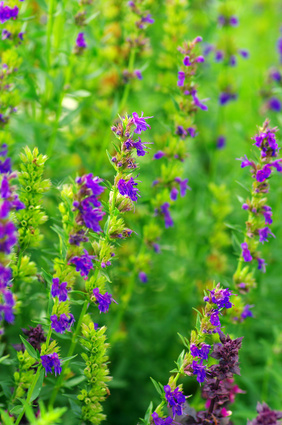
Hyssopus officinalis (L)
Synonyms and Common names: German = ysop, French = Hyssope officinale, Spanish = Hisopo
Order: Labiatae
 Description: Hyssopus is a perennial herb of
bushy habit. It grows up to 50cm tall, with square, richly branched and densely
leafy stems covered in downy hair. The opposite, almost sessile leaves are
narrowly tapering, blunt-tipped, leathery, glossy, almost glabrous, with sessile
small glands, and are entire with inrolled edges. The symmetrical flowers are blue-violet
in colour, appearing from July to October in groups of three to seven in the upper axils, forming single terminal spikes.
They have a tubular calyx
divided into five tapering teeth which terminate in a small spine. The
two-lipped corolla has a tube about as long as the calyx. The fruit are brown
nutlets. Hyssopus favours light dry soil in its natural habitat of southern
Europe but it is widely
cultivated elsewhere.
Description: Hyssopus is a perennial herb of
bushy habit. It grows up to 50cm tall, with square, richly branched and densely
leafy stems covered in downy hair. The opposite, almost sessile leaves are
narrowly tapering, blunt-tipped, leathery, glossy, almost glabrous, with sessile
small glands, and are entire with inrolled edges. The symmetrical flowers are blue-violet
in colour, appearing from July to October in groups of three to seven in the upper axils, forming single terminal spikes.
They have a tubular calyx
divided into five tapering teeth which terminate in a small spine. The
two-lipped corolla has a tube about as long as the calyx. The fruit are brown
nutlets. Hyssopus favours light dry soil in its natural habitat of southern
Europe but it is widely
cultivated elsewhere.
Parts used: Aerial parts, essential oil
Collection: The aerial parts are collected during July.
Constituents: up to 2% volatile oil (comprising pinocamphone, isopinocamphone, pinenes, camphine, terpinene, thujone and linalool, as well as over 50 other compounds), a glycoside (hyssopin), up to 8% tannins, flavonoids, insolic acid, oleonolic acid, a bitter substance (marrubiin), resin, gum
Actions: Relaxing expectorant, diaphoretic, sedative, carminative, pectoral, antispasmodic, nervine, peripheral vasodilator, anticatarrhal, topical anti-inflammatory, antiviral, emmenagogue
Indications: Bronchitis, chronic nasal catarrh. Has been used in hysteria, anxiety states and petit mal. Specifically indicated in bronchitis and the common cold.
Therapeutics and Pharmacology: Hyssopus is extensively used in the treatment of coughs, bronchitis and chronic catarrh, particularly in children and those of a nervous disposition. The volatile oil component has an antispasmodic action, while the marrubiin, also present in Marrubium, has expectorant qualities. As a diaphoretic, Hyssopus is beneficial in the treatment of the common cold in the management of influenza. Extracts of the herb have demonstrated antiviral activities, particularly against the Herpes simplex virus that causes cold sores. Externally, hyssopus can be used to treat burns and bruises.
The essential oil increases alertness and is used as an uplifting and gently relaxing nerve tonic, suitable for nervous exhaustion linked with overwork and anxiety, or for depression. It is of particular benefit in helping to ease feelings of grief and guilt.
Combinations: Hyssopus may be combined with Marrubium for bronchial catarrh or with Calendula flowers in childhood fevers. In the treatment of the common cold it may be mixed with Eupatorium perfoliatum, Sambucus flos. and Mentha piperata.
Caution: Excessive doses of Hyssopus affect the brain centres and can cause nervous disorders and trembling. The essential oil contains the ketone pino-camphene, which in high doses can cause convulsions, and so should only be used externally.
Preparation and Dosage: (thrice daily)
Regulatory Status: GSL Schedule 1
Dried herb: 2-4g or by infusion
Liquid Extract: 1:1 in 25% alcohol, 2-4ml
Tincture: 1:5 in 45% alcohol, 2-4ml
Additional Comments: Hyssop is derived from the Hebrew name Esob, although the hyssop often referred to in the Bible is more likely to have been a local variety of marjoram. Its name may also derive from the Greek word azob, or holy herb. Hippocrates recommended the herb for pleurisy and Dioscorides combined it with rue for the treatment of asthma and catarrh. Traditionally, it was strewn on floors and shelves to repel insects, or added to pot pourri and laundry rinses. It has also been used to kill head lice and intestinal worms. It was once popularly combined with figs to treat constipation. Hyssop is one of the 130 herbs used to flavour the liqueur Chartreuse.
Bibliography
Bartram, T. 1995 Encyclopedia of Herbal Medicine, 1st edn., Grace Publishers, Bournemouth.
Bremness, L. 1994 Herbs, Dorling Kindersley Eyewitness Handbook, London.
BHMA 1983 British Herbal Pharmacopoeia, BHMA, Bournemouth.
Chevallier, A. 1996 The Encyclopedia of Medicinal Plants, Dorling Kindersley, London.
Grieve, M. 1931 A Modern Herbal, (ed. C.F. Leyel 1985), London.
Hoffmann, D. 1990 The New Holistic Herbal, Second Edition, Element, Shaftesbury.
Hyperhealth 1996 Natural Health and Nutrition Databank, v.96.1 CD-ROM, ŠIn-Tele-Health, available from Healthworks, Leeds. ISBN 0-646-30942-0
Lust, J. 1990 The Herb Book, Bantam, London.
Mabey, R. (ed.) 1991 The Complete New Herbal, Penguin, London.
Mills, S.Y. 1993 The A-Z of Modern Herbalism, Diamond Books, London.
Ody, P. 1993 The Herb Society's Complete Medicinal Herbal, Dorling Kindersley, London.
Polunin, M. and Robbins, C. 1992 The Natural Pharmacy, Dorling Kindersley, London.
Prihoda, A. 1989 The Healing Powers of Nature, Octopus, London.
Weiss, R.F. 1991 Herbal Medicine, Beaconsfield Arcanum, Beaconsfield.
Wren, R.C. 1988 Potter's New Cyclopaedia of Botanical Drugs and Preparations, C.W.Daniel, Saffron Walden.










